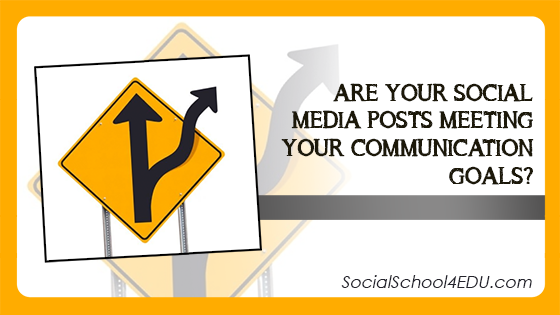By Barb Nicol, APR, President of Barbara Nicol Public Relations
Social media is an important communications tool. And just like your other communications tools – website, print materials, eNewsletters, community engagement meetings, etc – it should help support your overall communications goals. Getting likes, comments and shares may be a way to measure engagement – but do your posts support your goals? What do you want people to know, feel or do as a result of your post?
It’s easy to fall into the habit of posting things on social media because you have a good photo, want to promote an event, have established a special posting routine on certain days or need to fill your feed with something engaging. But it’s a major opportunity missed if you don’t take the time to align those posts with your overall communication goals.

State your goals.
In response to COVID-19, many are focused on using social media right now to showcase the great work taking place in schools to provide our students with the services they typically get in a traditional school setting but are now receiving in completely non-traditional ways.
While that’s great, take a minute to ponder why that matters. Is your goal to demonstrate to your community the value your schools provide, even when the world has been turned upside down? Is it to show parents that your staff is innovative and will move mountains to provide your students with the education they deserve? Is it to support parents as they try to juggle working from home with helping their child with their assignments while doing all the usual household chores? Is it to let staff know how much you appreciate them for their long hours and hard work? Clarifying your goals from the outset will help you identify what types of posts will help you get there.
Demonstrate your values.
In times of crisis, turn to your district’s values. We all understand the importance of compassion, concern, kindness, inclusivity and patience – especially in times of stress. These are all values that can be supported by what, how and when we communicate. If you frame your social media posts so they support your values as your goals, your posts will support your brand and demonstrate who you are as an organization. As Theodore Roosevelt is credited with saying, “People don’t care how much you know, until they know how much you care.”
Know your brand and know your community.
During this coronavirus pandemic, you may feel overwhelmed. You scour other school districts’ social media feeds, see cool things they are posting and try to copy as many as you can for your feeds. But every community is different, and your communications strategy should match your district’s personality and goals. While some districts have a playful brand, others are more conservative. One community may be having an easy time with the distance learning roll-out, while another may be struggling. Make sure your social media posts match your community’s reality. Authenticity is key to a successful social media strategy.

Modify your approach in times of crisis.
Whether written in a formal communications plan or not, you undoubtedly have overall communication goals. You may have goals related to enrollment, staff retention, voter approval or community pride. While all those goals may seem distant and unrealistic during this pandemic, there are still ways to support them.
Perhaps you have a referendum in your future, or are facing difficult budget cuts. While it may feel tone-deaf to share posts that focus on financial challenges given the recession that is likely to impact the majority of our community members – you can focus on trust, value, transparency and community pride. These all provide a solid foundation upon which to build a financial request or share difficult financial news when the time is right.
Maybe you are trying to recruit certain types of staff or improve staff satisfaction. While it may or may not seem like the time to post positions, you can demonstrate how much you value your staff, how important they are in the work being done and how you listen to what they need.
While it may feel inappropriate right now to roll-out an enrollment campaign, you can still showcase what great schools you have and how incredible your teachers are. You can provide parents with extra support, resources and ideas for how to manage during these crazy times. You can demonstrate that you are the education experts, and parents can trust you to deliver what their students need – in good times and in bad.
Build community through social media.
Much of what is being shared by districts on social media right now is exactly what our communities need to see and hear: school districts are providing what is needed to keep education moving, they are supporting their families, they have great staff who are incredibly creative and caring, and that we are all learning this “new normal” together. If you step back and write down your communication goals, you’ll be able to amplify the most important messages and align them with your goals. It may be a tweak in how you phrase something, a realization that you’re missing a golden opportunity to share things that didn’t occur to you, or an emphasis on certain kinds of posts over others.
In these strange and challenging times of COVID-19, many schools and districts are increasing and/or adjusting their social media presence and messaging. While it’s wise to consider modifying your approach in times like these, be sure you are aligning your social media posts with your overall communication goals.
Your goals can be supported through your social media posts. But only if you articulate those goals and use them to guide what you post, where you post and how you frame your posts.

This is a guest post by Barb Nicol, APR. Barb is president of Barbara Nicol Public Relations, which she founded in 1990 to focus on the communications needs of school districts and education organizations. Barb has supported dozens of school districts in creating and implementing effective communications strategies, served in leadership roles in state and national school public relations associations, and presented on numerous school communications topics.


